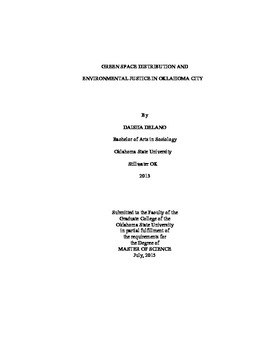| dc.contributor.advisor | Caniglia, Beth Schaefer | |
| dc.contributor.author | Delano, Daisha Lee | |
| dc.date.accessioned | 2016-09-29T18:39:34Z | |
| dc.date.available | 2016-09-29T18:39:34Z | |
| dc.date.issued | 2015-07-01 | |
| dc.identifier.uri | https://hdl.handle.net/11244/45246 | |
| dc.description.abstract | Environmental justice has long focused on the distribution of harmful environmental facilities that disproportionately affect low income and minority communities; however, recent work has begun to look at the distribution and access to environmental goods as well. Having access to green spaces can have a significant positive effect on individuals and communities. In urban areas where these spaces are often limited, it has been found that poor and minority communities are further from green spaces, and that the green spaces they do have access to are smaller and more run down. Green spaces and nature have positive impacts on individuals and communities ranging from physical environmental benefits, benefits to community and social cohesion, and benefits to individual's physical and mental health. Because of the wide range of benefits that green spaces provide, this has come to be considered an environmental justice issue. The aim of this study is to examine road based access to green spaces in the Oklahoma City area. ArcGIS was used to perform a network analysis of access to green spaces around the city from the centroid of each census block group within the city. Census block groups are organized to be as demographically homogenous as possible; therefore, these block groups were compared to determine differences in access based on percent racial minority, median income, and average level of education. Demographic data and census block group data were gathered from the U.S. census website, and shapefiles of Oklahoma City green space distribution, and Oklahoma City road network data were obtained from the Oklahoma City GIS (geographic information systems) department. Our findings indicate that census block groups with lower median income and higher percent minority are actually have closer road based access to green spaces in Oklahoma City. However, the green spaces that these census block groups have access to are smaller than the green spaces near census block groups with higher median income and smaller minority population. Future research should look at the quality and type of green spaces that are available to more clearly understand how they can affect the communities that live near them. | |
| dc.format | application/pdf | |
| dc.language | en_US | |
| dc.rights | Copyright is held by the author who has granted the Oklahoma State University Library the non-exclusive right to share this material in its institutional repository. Contact Digital Library Services at lib-dls@okstate.edu or 405-744-9161 for the permission policy on the use, reproduction or distribution of this material. | |
| dc.title | Green Space Distribution and Environmental Justice in Oklahoma City | |
| dc.type | text | |
| dc.contributor.committeeMember | Fullerton, Andrew | |
| dc.contributor.committeeMember | Mathews, Adam | |
| dc.contributor.committeeMember | Dunlap, Riley E. | |
| osu.filename | Delano_okstate_0664M_14209.pdf | |
| osu.accesstype | Open Access | |
| dc.description.department | Sociology | |
| dc.type.genre | Thesis | |
